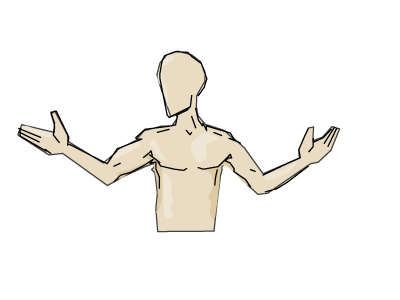
Think differently. Go beyond the ordinary and the obvious. Seek alternatives. Come up with new ideas. Experiment. Reflect. Reframe. Predict. Critique. Create the future. Can you imagine things in a different way? Are you always evaluating, guessing, exploring and challenging the norm? Welcome to the world of imagination! To imagine is to invent something in the mind and to create something through tuning and testing. The term imagination comes from the Latin verb imaginari meaning “to picture oneself". Everyone is born with imagination, but regular exercise of our imagination develops our power of mind. Everyone is born curious, with the will to learn and to know. Ask questions! Suspend judgment. Consider other points of view! Change your position. Think outside of yourself!
Curious + Critical + Creative
Activity 1 – Topsy Turvey

For the famous philosopher, Aristotle, imagination was a medium, or space, in an individual’s mind in which ‘images’ and ‘ideas’ were combined, affected by thought, and stored. It works like this: draw a picture in your journal of what you are looking at right now. Next, look at your view, but ask your brain to imagine being someplace else; or think about a person you’d like to see; or think about a scene of a movie; or think about a memory from the past week. You are connecting to your internal power. Now look up. Look at the ceiling of the room that you are sitting in. Pretend that the ceiling…is actually the floor! In your mind’s eye, walk through your room walking on the ceiling. Be sure to step over the thresholds into the next room. Now place drawings of your furniture on your ceiling. You are exercising your ability to turn ideas around in your mind.
Exercise your personal power! Turn things around. Turn things upside down. Think outside of the Box!
Activity 2 – Thinking Out of the Box

Thinking Out of the Box is an expression that means to consider a situation in a new light. The ability to keep coming up with new ways of looking at things: north, south, east, west, front, back, top, bottom, inside, outside, all around is an agility and a fun skill. Let’s try it! Work though these brain storming puzzles.
Think like Dr. Suess:
“Think left and think right,
and think low and think high.
Oh the thinks you can think up if you only try!”
Put your thinking cap on!
Activity 3 – Walk a While…

In this activity you will choose to be someone else. Thinking about other people and thinking from other people’s viewpoints is an important skill of a designer. Find a globe or open a map of the world. Close your eyes. Reach out and touch the map. Ready for an exchange adventure? Pretend that you were born at the location on the map. Then consider these questions: What time of day is it? What season is it? Where do you live? Do you go to school and if so, how do you get to school? What do you do for fun? What do you eat? What language do you speak? What does your neighborhood look like? What kind of clothes do you wear? Create a scenario of a different you somewhere else in the world. Write about the new you and print some pictures about your life. Submit these to your journal.
Activity 4 – Discover something new!
There is no joy more intense than coming up on a fact that cannot be understood in terms of currently accepted ideas.
Cecilia Payne, Composition of the Stars
How can imagination lead to discovery? What if what we believe to be the truth changes? For example, people used to think of the world as flat. It wasn’t until a Greek astronomer and philosopher and librarian discovered that measuring the angle of the shadow of an upright stick in the ground could become the basis for the measure of the circumference of the earth. The shift from thought to physical reality is often a huge leap… of imagination! What will you discover? What will you contribute? Explore the life work of Eratosthenes as he creates a method for measuring the Earth or Cecilia Payne’s discovery of Hydrogen and Helium as the stuff of stars!!
Write a short paragraph about their amazing discoveries and ask yourself….“What will I discover?”
Review

- Describe what it means to "think outside of the box."
- Your imagination is limited by the depth of your experiences.
- Name five places you have been "in your mind's eye."
- Is there such a thing as identical imaginations?
- Where is the imagination located according to Aristotle?
- Where did Plato think the imagination comes from?
Explore
- America By Design Innovation Series
- Archimboldo's Portraits, Smithsonian Video
- Aristotle Philosphy
- Artists Toolkits
- Brainstorming
- Chicago Labs
- Creative Modern Art Activities at MOMA, NY
- Creativity Quiz
- Design and the Elastic Mind
- Discover Design
- Do you see what I see?
- Historic Playground for the Imagination
- Imagination Playground
- Imagine MARS! by NASA
- Neave.com Imagination
- Neuroscience Lumosity
- Philosophy of Imagery
- Rube Goldberg Challenges your Imagination
- Run and Dream Monte Carlo
- Sir Ken Robinson on Creativity
- Solutioning Design
- TEDed Imagination of Isolated Civilizations
- TED Talks
- TED Technology, Entertainment, Design
- TED Where good Ideas Come From
- Terra Carta Design Lab Innovators
- The Fun Theory Innovation Awards
- The Idea Factory: Arnold Wassserman
- Thinking out of the Box: Brainstorming Puzzles
- Three Basic Principles of Creative Thinking
- Vegetable Orchestra
- Video 29 Ways to Stay Creative
- Video 29 Ways to Stay Creative
- Video Augmented City
- Video Buckminster Fuller on Geodesic Life
- Video Ideas Come From Everywhere
- VIdeo Neuroelectricity of Flow States
- Video: Training Yourself to Be More Creative
- Video Where Good Ideas Come From
- WYSS Institute Harvard



















































